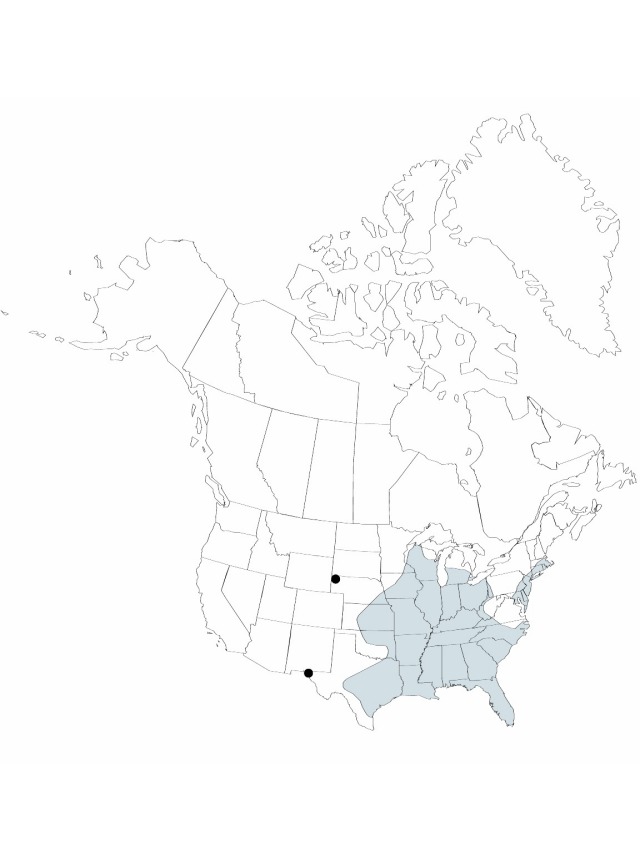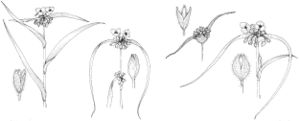Difference between revisions of "Tradescantia ohiensis"
Précis Découv. Somiol. 45. 1814.
imported>Volume Importer |
imported>Volume Importer |
||
| Line 69: | Line 69: | ||
|publication year=1814 | |publication year=1814 | ||
|special status=Illustrated;Endemic | |special status=Illustrated;Endemic | ||
| − | |source xml=https:// | + | |source xml=https://bitbucket.org/aafc-mbb/fna-data-curation/src/2e0870ddd59836b60bcf96646a41e87ea5a5943a/coarse_grained_fna_xml/V22/V22_61.xml |
|genus=Tradescantia | |genus=Tradescantia | ||
|species=Tradescantia ohiensis | |species=Tradescantia ohiensis | ||
Latest revision as of 20:32, 5 November 2020
Herbs, erect or ascending, rarely rooting at nodes. Stems 15–115 cm; internodes glabrous or occasionally pilose, glaucous. Leaves spirally arranged, sessile, forming acute angle with stem, arcuate; blade linear to linear-lanceolate, 5–45 × 0.4–4.5 cm (distal leaf blades equal to or narrower than sheaths when sheaths opened, flattened), apex acuminate, glaucous, usually glabrous, sometimes pilose near sheath. Inflorescences terminal and often axillary; bracts foliaceous. Flowers distinctly pedicillate; pedicels 0.7–3 cm, glabrous; sepals glaucous, 4–15 mm, glabrous or with apical tuft of eglandular hairs; petals distinct, deep blue to rose, rarely white, broadly ovate, not clawed, 0.8–2 cm; stamens free; filaments bearded. Capsules 4–6 mm. Seeds 2–3 mm. 2n = 12, 24.
Phenology: Flowering late winter–fall (Feb (Fla)–Sep).
Habitat: Roadsides, railroad rights-of-way, fields, thickets, less commonly in woods, occasionally along streams
Distribution

Ont., Ala., Ark., Conn., Del., D.C., Fla., Ga., Ill., Ind., Iowa, Kans., Ky., La., Md., Mass., Mich., Minn., Miss., Mo., Nebr., N.J., N.Y., N.C., Ohio, Okla., Pa., R.I., S.C., Tenn., Tex., Va., W.Va., Wis.
Discussion
Tradescantia ohiensis is the most common and widespread species in the United States. It hybridizes with many of the other species.
Tradescantia ohiensis var. foliosa (Small) MacRoberts has been recognized for the forms with pilose leaves and sheaths (D. T. MacRoberts 1977). I have found such plants scattered among populations of glabrous plants, and I do not consider them worthy of formal taxonomic status.
The following hybrids are known: Tradescantia ohiensis × T. gigantea, in Louisiana and Texas; T. ohiensis × T. hirsuticaulis, Arkansas; T. ohiensis × T. occidentalis, Arkansas, Louisiana; T. ohiensis × T. ozarkana, Arkansas; T. ohiensis × T. paludosa, Louisiana (reported by MacRoberts, 1980); T. ohiensis × T. roseolens, Alabama, Florida; T. ohiensis × T. subaspera, Alabama, Georgia, Mississippi, North Carolina, South Carolina, Tennessee, Virginia, West Virginia; and T. ohiensis × T. virginiana, Georgia, Kentucky, Maryland, Mississippi, North Carolina, South Carolina, and Virginia.
Selected References
None.
